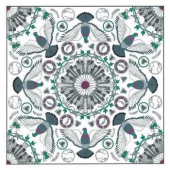
Modern Nature
How To Live
Label: Bella Union
Genre: Rock / Pop
Availability
- LP + MP3 COUPON €27.99 Dispatched within 5-10 working days
The lines between city and country were on Jack Cooper’s mind when he named his new band Modern Nature. He took the phrase from the diaries of filmmaker Derek Jarman, written on the coast of Kent in his Dungeness cottage. Visiting Jarman’s home, Cooper was struck by what he calls a “weird mix of urban and rural” - such as the way a nuclear power station sits next to open grasslands.
On Modern Nature’s debut album, How to Live, urban and rural cross into each other. Plaintive cello strains melt into motorik beats. Pastoral field recordings drift through looping guitar figures. Rising melodies shine with reflective saxophone accents, placing the record somewhere in the Bermuda Triangle between the expansive motorik of Can, the Canterbury progressiveness of Caravan and the burgeoning experimentalism of Talk Talk’s Colour Of Spring.
Throughout this continuous work, where no song ever really seems to end, there’s an indelible feeling of constant forward motion. It’s as if the band is laying down a railway and riding it simultaneously, and you can hear all kinds of landscapes passing by.
The endless feel of How to Live was inspired by Cooper’s experience making his 2017 solo album Sandgrown. It was the first time he made a record with a defined theme - a suite of songs about his hometown of Blackpool - and imposing a narrative framework turned out to be refreshingly liberating. “When I started thinking about a new project,” he recalls, “going back to making an album of unconnected songs seemed as strange as making a movie with completely unconnected scenes.”
As he began writing songs, Cooper was also tuning to the vibes of Earth Loop, an instrumental solo album by BEAK>’s Will Young (under the name Moon Gangs). For a long time, Cooper had hoped to work more with Young, who almost joined his first band, Mazes, and was in the touring version of his next group, Ultimate Painting. So he decided now was finally the time, as he puts it, “to make good on hundreds of late night 'we should really do music together' conversations.”
“Over the next few weeks I started sending Will songs, and we began meeting up, working on ideas and formulating the bigger picture as it were,” Cooper recalls. “Approaching the album as a film or play made complete sense, and from that came the idea to have a very defined narrative, reoccurring themes and chord progressions, field recordings and a set palette of instruments and sounds. Each song came with pages and pages of notes, musical references, films, books, places, words and feelings.”
Cooper is hesitant to explain too much about How To Live’s story, preferring to let the listener to find his or her own narrative to fit what they hear. But he can offer some guideposts. “Broadly speaking, the album moves from an urban environment at the beginning to an escape at the end...whether that's solitude or acceptance or isolation,” he says. “At the beginning the songs reflect a different type of isolation, the sort of isolation or disassociation one can only feel in a very crowded, hectic environment.”
The vibrations of these environments come across immediately on How To Live. The album’s first line is “There’s a hum in the street,” and the rest of the hypnotic “Footsteps” masterfully paints a picture: “the click repeats, repeats, repeats”....”Isolation, repetition, spark burst fission”...”turns loops to the point in which they meet.”
Throughout the remainder of the record, ideas recur and sounds return, often forming new shapes. A careful guitar pattern sprouts into the halting “Seance”, which ends with that same guitar pattern flipped into reverse. The beatific “Peradam” revels in the cycles of nature, as Cooper asks to be led “out of spirit worlds, let it whirl, out and in, swirling like fireflies. The pulsing “Nature” takes a darker view of our current environment, calling it “the great failure” and concluding with the imperative to “lock them up and don’t forgive them.”
The richness of the ideas in these songs is matched by the resonance of the music. Cooper and Young’s organic compositions gain skin and muscle through the thoughtful cello of Rupert Gillett, the insistent drumming of Aaron Nevue (of compatriot outfit Woods), and the expressive saxophone of Jeff Tobias, from Brooklyn jazz/rock juggernaut Sunwatchers. Each track on How to Live evolved as these creative forces joined the group, and it shows. The entire album courses with both precision and vitality. The band is closely tuned to the core of each piece, but also unafraid to throw themselves into every moment.
The care that went into How To Live is clear in album notes, which map out impressionistic ideas behind each step - one block describes the song “Nightmare” as “the calm after the storm, nihilism, acceptance!! HOW TO LIVE??” - and include a list of the music and film inspirations behind the band and their work. But ultimately, the music on How to Live speaks for itself. It’s a work of surprising layers and limitless depths, impressing more strongly with each listen. Modern Nature may have been inspired by the line between urban and rural, but with How To Live they’ve gone a step further, and created their own complete world.
